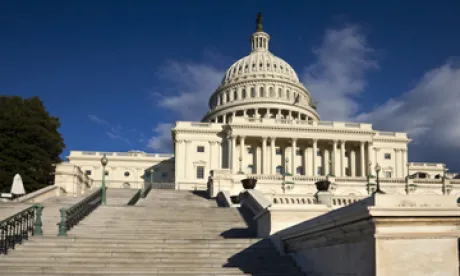Infrastructure Plan Scuttlebutt
With Congress not returning to Washington, D.C., until next week, the White House’s American Jobs Plan proposal is still driving much of the political discussion in town this week. Of course, we still do not know what might be contained in an actual infrastructure bill, though we received a few clues this week regarding both process and substance surrounding the proposal.
-
Reconciliation an option for Dems. This week, Democrats indicated that the Senate parliamentarian had given them the green light to further use the budget reconciliation process to pass legislation with a majority of votes, thus avoiding a filibuster that requires 60 votes to overcome. Traditionally, use of the budget reconciliation process has been limited to once per fiscal year (which roughly translates to twice per calendar year because the fiscal year runs from October 1 to September 30). Congressional Democrats used budget reconciliation to pass the American Rescue Plan Act (ARPA). The Senate parliamentarian’s ruling (which has not been released publicly) might allow Democrats to use reconciliation two more times before the calendar year is up.
-
Manchin stands by the filibuster. The use of reconciliation to move an eventual infrastructure package is crucial for Democrats because Senate Republicans—who are not supportive of the infrastructure proposal at this time—can use the legislative filibuster to block the bill. This week, Senator Joe Manchin (D-WV) offered further support for the filibuster in an opinion piece in which he wrote:
“That is why I have said it before and will say it again to remove any shred of doubt: There is no circumstance in which I will vote to eliminate or weaken the filibuster. The time has come to end these political games, and to usher a new era of bipartisanship where we find common ground on the major policy debates facing our nation.”
-
Dems’ House majority narrows. Passing legislation in the U.S. House of Representatives isn’t getting any easier for Democrats either. The margin between the parties in the House continues to narrow. When the House returns next week, there will be 218 Democrats and 212 Republicans. Since passage of the ARPA, Marcia Fudge (D-OH) resigned to be secretary of housing and urban development, Deb Haaland (D-NM) resigned to become secretary of the interior, and Alcee Hastings (D-FL) passed away. This means that Democrats can afford to lose only two votes in order to pass legislation, which could present a challenge for the passage of the expansive infrastructure proposal.
-
Paid leave included? The White House’s infrastructure framework discusses the “care economy,” and this week Richard Neal (D-MA), chair of the House Committee on Ways and Means, told his colleagues in a letter that the “caring infrastructure” includes paid leave: “We will give every worker the right to paid family and medical leave,” he wrote, “whether it’s because they’ve just welcomed a new child into their family, they have a loved one in need of care, or they are dealing with their own medical issue.” At this stage of the process, we do not have any details on the contours of such leave provisions or whether they would survive the legislative process.
Hurry up and Wait
For months, worker advocates and Democrats have been calling on the Occupational Safety and Health Administration (OSHA) to issue an emergency temporary standard (ETS) to protect workers from COVID-19. On January 21, 2021, President Joe Biden doubled down on these demands when he issued an executive order instructing OSHA to consider issuing an ETS by March 15, 2021. Now, about one month after that deadline, an ETS is still on the drawing board. Moreover, it was reported this week that Secretary of Labor Marty Walsh has pulled back the draft ETS for further review. With vaccinations increasing daily, it may be harder for the administration to justify issuing the ETS.
DOL Issues COBRA Guidance
On April 7, 2021, the U.S. Department of Labor’s (DOL) Employee Benefits Security Administration (EBSA) published answers to frequently asked questions (FAQs) to help stakeholders understand and implement the Consolidated Omnibus Budget Reconciliation Act (COBRA) premium subsidy provisions contained in the ARPA. Those provisions require employers to pay 100 percent of the COBRA premium costs for eligible individuals who have been laid off, furloughed, or had their hours reduced. (Employers can recover these costs through credits against their Medicare taxes.) The FAQs address eligibility, applications for premium assistance, and details of the notice requirements, among other matters. Additionally, EBSA published model notices related to the subsidy requirements.
DOL Relaunches Persuader Reporting Program
This week, the DOL’s Office of Labor-Management Standards announced the relaunch of its Persuader Reporting Orientation Program. The program, which was in effect during the Obama administration, is intended to “inform employers and their representatives about potential reporting obligations under the Labor-Management Reporting and Disclosure Act.” The program does not change reporting requirements or set forth any new obligations for employers. However, the program’s relaunch could serve as an indicator of the administration’s potential desire to regulate in this space.
Legislators Move to Rescind Trump-Era Regulations
April 4, 2021, was the deadline for federal legislators to introduce resolutions of disapproval under the Congressional Review Act (CRA), which generally allows Congress to rescind “midnight” regulations by majority votes in each chamber. The Buzz has discussed the resolution to rescind the U.S. Equal Employment Opportunity Commission’s regulation that injects transparency into the conciliation process. In addition, five other resolutions have been introduced to rescind regulations promulgated by the U.S. Environmental Protection Agency, the U.S. Department of the Treasury, the U.S. Securities and Exchange Commission, the U.S. Department of Health and Human Services, and the U.S. Social Security Administration. If a rule is rescinded pursuant to the CRA, an agency cannot issue a rule that is “substantially the same” unless authorized by Congress.
Give Me Liberty, or Give Me Desk
April 7, 2021 marked the 108th anniversary of a moment in the history of the House of Representatives that may seem trivial, but which played a crucial part in how the House has operated ever since: getting rid of members’ desks in favor of auditorium-style, “first-come-first-served” bench seating. From the United States’ founding, as more states were admitted to the union, Congress naturally continued to grow. By 1913, the House of Representatives had 435 voting members and 5 non-voting members, but only 401 desks. The initial space-saving idea was to have members sit facing each other on long benches, as in the House of Commons in the United Kingdom, but that plan was soon discarded in favor of auditorium-style seating. Fortunately, by that time, individual member desks had become less necessary, as the first building for representatives, the Cannon House Office Building, had just been completed a few years prior, in 1908. Transferring more work from the House chamber to the Cannon Building across the street increased the efficiency and professionalism of the House, as committees could meet more frequently, members could more easily meet with constituents, and staff could be hired to assist with the members’ increasing workloads.




 />i
/>i

